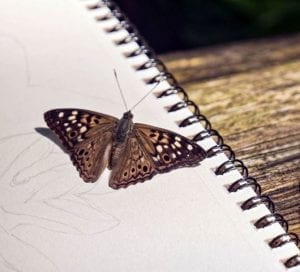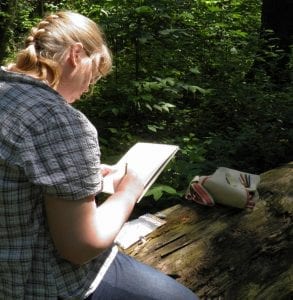 Why do some types of vines always wind clockwise while others turn counter?
Why do some types of vines always wind clockwise while others turn counter?
Have you ever noticed that your garden always blooms in a particular succession, only to be completely thrown off by the weather one year?
These are examples of questions that beg to be answered by those who are watchful of the natural world. The search for those answers might lead you to a deeper connection with life, a keener eye for drawing or might even provide helpful data to scientists studying changes in the climate.
Giving yourself some quiet time to observe nature, to write or draw about it, focuses ones attention. As you begin to notice details you hadn’t seen before, what was once passed over as commonplace becomes extraordinary. It is in noticing these details that the curiosity begins. It is this sense of curiosity and wonder that opens the door to understanding, and along with increased understanding, comes deepened observation skills, expanded writing, drawing and communication skills, development of a “personal voice,” and practice in the use of the scientific process to investigate answers.
Students who engage in nature journaling often move through viewing the out of doors as a place solely for recreation to a place of discoveries — an extended classroom. By narrowing journaling practice to a small well-defined outdoor area that is revisited repeatedly, teachers can allow for some familiarity of place so that students can witness changes over time and make important connections that inform a stonger understanding of science.
Diane W. Husic, Ph.D., Chair and Professor, Department of Biological Sciences, Moravian College, explains the value of involving the community in journaling: “As an educator and a conservationist, two of my greatest concerns are a) how seldom people get outside to appreciate nature, to truly observe the wonders in the natural world; and b) the increasing public distrust of science. If people don’t appreciate the environment around them, then who is going to fight to preserve our resources and the natural beauty of wild places? And if we don’t trust science, then how can we work together to understand how our world is changing and how we can work to save our environment from the many threats we place upon it? Science, beautifully and unexpectedly touches the lives of all of us, and too few people appreciate that.”
For local horticulturist and garden writer, Pam Ruch, drawing and writing in her field journal “is not about capturing images but about uncovering stories. …The story of the world, which holds a million other stories, is one without an ending.”
Excerpt from writings of Pam Ruch —
For the past six weeks I have gone nowhere (well, almost nowhere) without my journaling bag of tricks—binoculars, a loupe, a ruler, pens, colored pencils—and I’ve practiced the art of observation. I saw dodder twining counterclockwise around and around the winged stems of Verbesina alternifolia and slowly, over the weeks, sucking the life out of them. I saw a cicada climbing a broomstick, and a trio of ants carrying a dead earthworm down under. I spied on a green heron. One morning I watched as four species of bees gorged themselves on pollen on the face of a sunflower. A week later the bumblebee, or her hivemate, was still methodically combing through the approximately two thousand disc florets so that each and every one would reach seedhood. I defy anyone to closely observe a bumblebee at work and not come away with admiration and even affection for the industrious creature.


